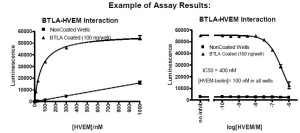The treatment of diseases by inducing, enhancing, or surpressing an immune response is referred to as Immunotherapy. T-cell activation and inactivation requires the coordination of various co-inhibitory and co-stimulatory signals and most immunotherapies modulate these signals.
Therapeutic manipulation of immunopathways has lead to promising clinical results for the treatment of a number of diseases such as cancer, autoimmune diseases and inflammatory diseases. Research in this field is rapidly evolving as scientists seek to identify the next generation of therapies.
In the third and last article in this series, I’ll describe the BLTA:HVEM and CD47:SIRPα pathways and summarize the portfolio of tools to investigate this pathway produced by our partner BPS Biosciences. In the first article, I focused on B7-1 : CD28 and B7-1 : CTLA4 pathways, and in the second article the emphasis was on the PD-1/PD-L1/PD-L2 pathway.
After a brief summary of the impact of these pathways in immune response, we’ll be looking at the screening tools I’ve selected from our partner BPS Biosciences to investigate these pathways in drug discovery activities, and especially in inhibitor screenings. In fact, some of these tools are the first ready-to-use assays to screen for inhibitors of the respective pathways.
Why study the BLTA:HVEM pathway in immunotherapeutics?
HVEM, also known as herpesvirus entry mediator, is the receptor for the HSVglycoprotein D involved in viral entry. It’s also the receptor for several ligands, including BTLA or CD160, which deliver a co-inhibitory signal to down-regulate T cell response. For example, BTLA activation inhibits the function of human CD8+ cancer-specific T cells. Conversely, the binding of two other ligands, LIGHT or lymphotoxin-α, deliver a costimulatory signal. Thus, HVEM is a bidirectional switch, with the outcome depending on which ligand is engaged. A cysteine-rich domain (CRD1) of HVEM is required for the binding of inhibitory ligands CD160 and BTLA but not stimulatory ligand LIGHT. Therapies targeting the CRD1 of HVEM to block BTLA and CD160 binding are being developed to enhance immune responses and vaccination.
BTLA can also bind to another receptor, B7-H4. Like BLTA binding to HVEM, BTLA engagement of B7-H4 results in downregulation of T-cell activation, and mice deficient in BTLA show increased incidence and severity of autoimmune disorders.
The most advanced BLTA:HVEM screening reagents
These new therapeutical advances highlight the importance of reliable R&D tools in Drug discovery approaches and translation medicine programs. Access to robust research reagents covering the needs of Drug discoverers from target validation to screening (HTS or secondary) or even DMPK studies is crucial. I have made a selection of some of the latest releases for scientists interested in the BLTA:HVEM pathway.
#1 – BTLA – a ligand for HVEM and B7-H4
BTLA (CD272) (Id. nr 71141) is a ligand for nHVEM and B7-H4, a mediator of co-inhibitory signals to down-regulate the T cell response.
#2 – HVEM – a receptor for BTLA
HVEM is one of the receptors for BTLA. Furthermore it serves as the receptor for the HSVglycoprotein D involved in viral entry.
HVEM is available as a Fc fusion (Id. nr 71142) and as a biotinylated Fc fusion (Id. nr 71143).
#3 – B7-H4 – a receptor for BTLA
B7-H4 is another receptor for BTLA. Complex formation also results in downregulation of T-cell activation.
B7-H4 is available as a His tagged version (Id. nr 71144) and as a biotinylated version (Id. nr 71129).
Ready-to-use BLTA:HVEM4 screening assay kits

Why study the CD47:SIRPα pathway in immunotherapeutics?
CD47 is an anti-phagocytic signal found on many cancer cells that signals macrophages not to “eat” the cancer cell. It binds to the SIRP-α receptor on the surface of macrophages and dendritic cells. Anti-CD47 antibody therapy inhibited tumor growth and prevented metastasis in mice, suggesting CD47 blockade may be an important immunotherapeutic target for human cancer.
Products available
#1 – CD47 – a ligand for SIRP-alpha receptor
CD47 (Id. nr 71127) binds to the SIRP-α receptor on the surface of macrophages and dendritic cells.
#2 – SIRP-alpha (CD172a)
SIRP-α (Id. nr 71145) is located on the surface of macrophages and dendritic cells and serves as the receptor for CD47.
Looking for BLTA:HVEM or CD47:SIRPαtestings?
Choosing the right reagents or screening kits to raise the value of your compounds of interest by looking to BLTA:HVEM or CD47:SIRPα pathways can be challenging.
Research tools reviewed in this final post (of a series of 3 posts dedicated to Immunotherapy screening) will definitely help you there. Otherwise, you can simply contact me with the form below.
[contact-form to=’Ali.el.baya@tebu-bio.com’ subject=’I am interested in Immunotherapy related screening products’][contact-field label=’Name’ type=’name’ required=’1’/][contact-field label=’Email’ type=’email’ required=’1’/][contact-field label=’Comment’ type=’textarea’ required=’1’/][/contact-form]



